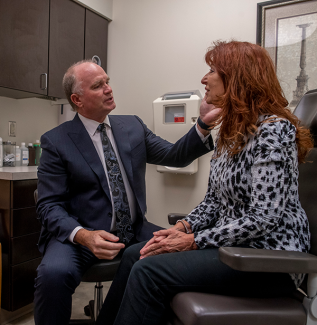Facelift surgery overview
If you are bothered by the signs of aging in your face, a facelift may be right for you. Technically known as rhytidectomy, a facelift is a surgical procedure to improve visible signs of aging in the face and neck, such as:
- Jowls
- Fat that has fallen or is displaced
- Deep folds between the nose and mouth
- Loss of muscle tone in the lower face, sagging of facial skin
- Loose skin and excess fatty deposits under the chin and jaw
What’s the concept?
Facial aging involves both skin texture changes and the descent of facial fat, which accounts for the difference in facial shape from youth to middle-age. The main goal in face lifting is to restore the facial profile to a contour exhibited during your youth, such that our patients appear both more youthful and beautiful while continuing to look like themselves. A facelift is performed through concealed access incisions that are contoured around the ear. These access incisions allow exposure of the deeper facial soft tissues so that descended facial structures may be more youthfully repositioned.
Improvements in the neck are obtained by contouring the sagging muscle of the neck, as well as the removal of excess neck fat. The anterior neck is addressed through a small incision under the chin, allowing accurate correction of the laxity and banding noted in the aging neck, providing a sculpted jawline and longer-lasting result.
A facelift is designed to correct all of these aging features, restoring a more youthful, rested appearance with uplifted contours and improved tone in facial skin and underlying muscle. The most significant correction occurs from the neck up to the cheeks. Eyelid surgery and brow lift can be done at the same time, addressing the eyes and forehead.
Facial aging is a complex process. Each patient ages differently, and the key to successful facial rejuvenation is to understand the anatomic and aesthetic changes which have occurred for a particular patient and formulate a patient-specific treatment plan.
Are there different types of surgical facelift techniques?
Yes. The most common type of facelift is a two-layer or SMAS facelift. This tightens the fascia and deeper muscle layer first and then re-drapes the loose skin of the face and neck. The excess skin is removed and sutured into place without tension. The key to a surgical facelift is avoiding skin tension, reconstructing the internal anatomy beneath the skin, shaping the face by repositioning the deeper soft tissues and muscles. The deep tissues are used to move and hold the face in the more youthful positions, not the skin. This is the technique that Dr. Wilson uses in his facelift procedure.
Minimizing skin tension also provides greater control in producing consistent, imperceptible scars and no change in the appearance of the hairline or earlobes.
A facelift needs to be designed for your individual needs and to address your specific concerns. Remember, the goal is to have you look rested and youthful but not pulled, tight, stretched, or artificial.
If there is only a little loose skin at the cheeks or neck, a mini facelift or skin-only facelift can be performed. Mini facelifts can also be used as a refresher after a previous facelift. The excess skin, fascia, or fat removed may be used to augment lips or fill lines in the face.
Fat grafting is commonly done during a facelift procedure.
Be aware that many facelift surgeons have named or “branded” their facelift procedures as something unique. This is good marketing but not really true. Dr. Wilson has been trained and utilizes all of the best techniques to create your individual results.
Selecting a surgeon
Picking the right surgeon is the single most crucial decision you will make in optimizing the safety and benefits of your facelift. Insist on a board-certified plastic surgeon such as Dr. Wesley G. Wilson. Clearly and specifically communicate your goals and desires to your doctor. Ask to see “before and after” pictures of the surgeon’s facelift procedures.
Are you a good candidate for facelift surgery?
You should be in good general health. Non-smokers are preferred. If you smoke, you must stop, at least for a period before and after your surgery as directed by your doctor. Before scheduling your procedure, your surgeon will go over your complete medical history. You may be directed to suspend the use of any supplement or medication that may promote excessive bleeding. Your doctor may also want to perform bloodwork and other lab tests.

Facelift procedure
Your facelift will be performed at UT Day Surgery . You will be directed to stop eating and drinking for several hours before your surgery, as determined by your doctor. After checking into the surgical facility, your skin will be prepped for surgery, and you will be administered your recommended form of anesthesia, either general anesthesia or a combination of local anesthesia and sedation. In most cases, you can go home the day of your surgery, but make sure you have arranged for a driver.
Facelift Recovery
You will likely have some mild to moderate discomfort following your facelift. Your doctor will prescribe medication as appropriate. Some bruising is to be expected. Make sure you have arranged for some help at home for at least a few days. Keep your head elevated above your heart to help decrease swelling and bruising. Do not pick at your incision sites and avoid wearing makeup for a while. Avoid vigorous activity and stay out of the sun until your recovery is complete, usually taking about a month.

Facelift Results
A facelift turns back the hands of time but doesn’t stop time from moving forward. You will quickly see results, but be aware aging continues from the day of surgery. Results on average last 10 to 12 years. Secondary facelifts can be done by reusing old incisions to retighten the skin that gravity and age have loosened. Staying in good shape and caring for your skin will optimize and prolong your results.


